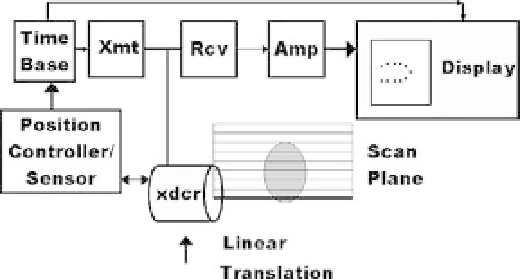Biomedical Engineering Reference
In-Depth Information
FIGURE 16.4
Basic elements of a pulse-echo imaging system shown with mechanical scanning. Note that a
position controller/sensor is included along with a different form of information display compared to that of an
echo ranging system.
cameras using long time exposures. The imaging presentation shown here was called B-
mode, or brightness mode, in which the echo amplitudes were assigned white for maximum
and black for minimum. Later, as electronics improved, a true gray scale for intermediate
amplitudes could be implemented so more subtle differences among tissues could be seen.
Other investigators worked on arrays, an arrangement of small transducers that could be
electronically switched and excited so mechanical movement of a single transducer could
be replaced by rapid real-time array imaging. Two contributors were J. C. Somer, who
showed that ultrasound phased arrays were possible in 1968, and N. Bom, who developed
the first linear arrays in 1971 in the Netherlands. By the 1980s, almost all commercial imag-
ing systems used arrays.
Many other important developments followed, some of which are highlighted in Sections
16.2.6 and 16.2.7. Some of the upcoming topics that make modern ultrasound imaging pos-
sible are scattering and absorption from tissues, transducers, focusing with arrays, imaging
systems, and special signal processing methods.
16.2.2 Acoustic Wave Propagation, Reflection, and Refraction
Ultrasound imaging is based on waves that are sent into the body and received. A wave
is a disturbance that moves through or along the surface of a medium. A small rock
dropped on a smooth surface of water will create ripples in the form of expanding circles.
In other words, the disturbances in time also have a spatial extent.
Two useful simple models for wave propagation are the plane wave and the spherical
wave. A model for a spherical wave consists of a sphere expanding in radius with increas-
ing time. A plane wave is a one-dimensional model that assumes that the lateral dimen-
sions of the wave perpendicular to the direction of propagation are infinite in extent.
A simple one-dimensional wave can be described by
p
ð
z
,
t
Þ¼
A
exp
ð
i
o
ð
t
z
=
c
0
ÞÞ þ
B
exp
ð
i
o
ð
t
þ
z
=
c
0
ÞÞ
ð
16
:
7
Þ
where
t
is time, and
z
is the propagation coordinate.


